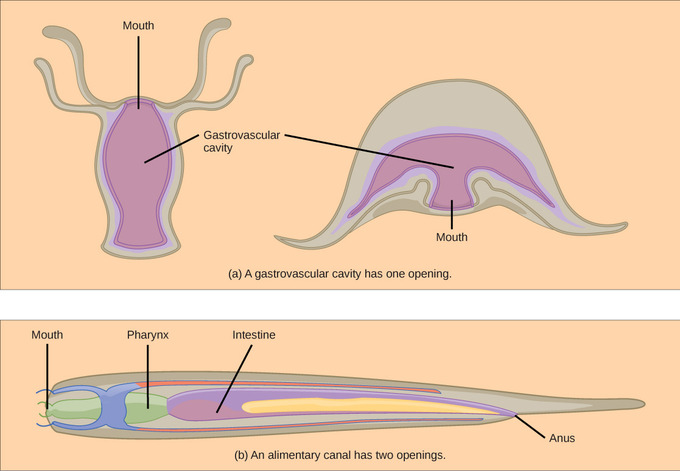34.3: Digestive Systems - Invertebrate Digestive Systems
- Page ID
- 13842
- Explain the digestive process in invertebrates
Invertebrate Digestive Systems
Animals have evolved different types of digestive systems break down the different types of food they consume. Invertebrates can be classified as those that use intracellular digestion and those with extracellular digestion.

Intracellular Digestion
The simplest example of digestion intracellular digestion, which takes place in a gastrovascular cavity with only one opening. Most animals with soft bodies use this type of digestion, including Platyhelminthes (flatworms), Ctenophora (comb jellies), and Cnidaria (coral, jelly fish, and sea anemones). The gastrovascular cavities of these organisms contain one open which serves as both a “mouth” and an “anus”.
Ingested material enters the mouth and passes through a hollow, tubular cavity. The food particles are engulfed by the cells lining the gastrovascular cavity and the molecular are broken down within the cytoplasm of the cells (intracellular).
Extracellular Digestion
The alimentary canal is a more advanced digestive system than a gastrovascular cavity and carries out extracellular digestion. Most other invertebrates like segmented worms (earthworms), arthropods (grasshoppers), and arachnids (spiders) have alimentary canals. The alimentary canal is compartmentalized for different digestive functions and consists of one tube with a mouth at one end and an anus at the other.
Once the food is ingested through the mouth, it passes through the esophagus and is stored in an organ called the crop; then it passes into the gizzard where it is churned and digested. From the gizzard, the food passes through the intestine and nutrients are absorbed. Because the food has been broken down exterior to the cells, this type of digestion is called extracellular digestion. The material that the organism cannot digest is eliminated as feces, called castings, through the anus.
Most invertebrates use some form of extracellular digestion to break down their food. Flatworms and cnidarians, however, can use both types of digestion to break down their food.
Key Points
- The simplest invertebrate digestive system in a gastrovascular cavity consists of only one opening that serves as both the mouth for taking in food and the anus for excretion.
- The gastrovascular cavity has cells lining it that secrete digestive enzymes to break down the food particles through a process called intracellular digestion.
- An alimentary canal is a long tube that begins with a mouth, then goes to the esophagus, then to the crop, gizzard, intestine, and finally, to an anus; this is used in the process of extracellular digestion.
- Most invertebrates use extracellular digestion; however, there are a few phyla that can use both intracellular and extracellular digestion.
Key Terms
- alimentary canal: the organs of a human or an animal through which food passes; the digestive tract
- intracellular digestion: Intracellular digestion is a form of digestion which takes place within the cytoplasm of the organism. Intracellular digestion takes place in animals without a digestive tract, in which food items are brought into the cell for digestion.
- extracellular digestion: Extracellular digestion is a process in which animals feed by secreting enzymes through the cell membrane onto the food. The enzymes break the food into molecules small enough to be taken pass through the cell membrane into the cell. These nutrients are transferred into the blood or other body fluids and distributed to the rest of the body.
- extracellular: occurring or found outside of a cell
- casting: the excreta of an earthworm or similar creature
- intracellular: Intracellular digestion is a form of digestion which takes place within the cytoplasm of the organism. Intracellular digestion takes place in animals without a digestive tract, in which food items are brought into the cell for digestion.


